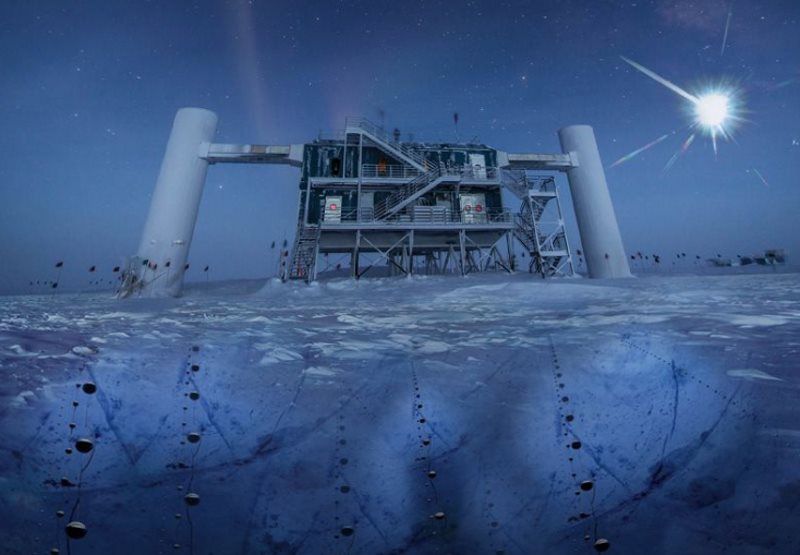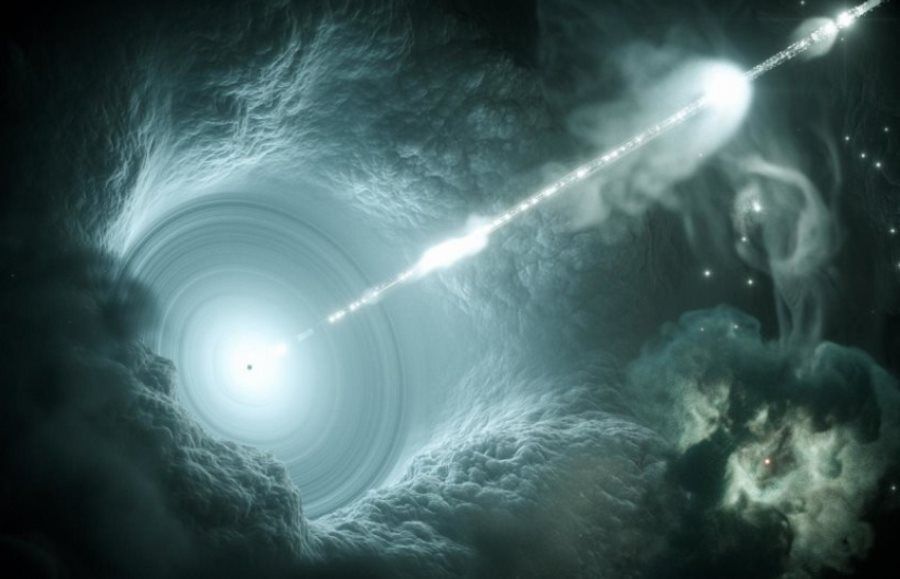Blazar source of “ghost particles”. First detection of neutrinos from outside our galaxy
Astronomers from several scientific institutions have reported locating a distant source of high-energy ghost particles. Researchers have pinpointed the source of neutrinos outside our galaxy for the first time ever, and it is a blazar located nearly 4 billion light years from Earth, designated TXS 0506+056.
Neutrinos are ultralight elementary particles. They have no electrical charge, and their negligible mass allows them to subrótravel vast distances of orders of magnitudeóin a billionóin light years. Although next to the photonów are the most widespread particles in the Universe, there is still not much known about them. This is because neutrinos interact very weakly with matter. So faint that they are often referred to as "particles-spiritów". Able to penetrate through most of the objectów without leaving a trace behind. Matter appears transparent to them.
To date, researchers have only learned about two sources of neutrinosódła neutrinos. This is the Sun and the supernova 1987A. For 30 years, when the detection of neutrinos from the aforementioned supernova occurred, researchers have been constantly looking for other sources ofójets of high-energy cosmic radiation.
Last September, the IceCube neutrino telescope located in Antarctica recorded several neutrinos. This event has triggered an observational campaign by scientistsów whichóFor years, researchers have been looking for another source of these particlesósource of these particles. Observation campaign, in whichórej scientists from Germany have played a key role, is a decisive step toward solving the mystery thatóra has kept scientists awake for more than 100 years. The point is to determine the exact sourcesódeles of cosmic rays – high-energy subatomic particles, whichóre constantly bombarding the Earth’s atmosphere.
The observing campaign was carried out across the entire range of the electromagnetic spectrum – From radio waves, to gamma rays. The observations have had an effect. Scientists have determined that the exotic particle originated in a galaxy 3.7 billion light-years away in the constellation Orion, where a monstrous black hole served as a natural particle gas pedal This blazar TXS 0506+056.
Scientists from 18 róThe question is to determine the exact source of theóin involved in the discovery, presented the findings in a dwóch papers published in „Science” (1,2). The first paper is about the discovery of the source of theóThe other indicates that other neutrinos previously recorded by IceCube came from the same sourceódna.

Schematic of the IceCube with sensors mounted under the ice. Fot. IceCube/NFS
Demonstrating the presence of neutrinos, however, is extremely complicated because most ghost particlesów permeates the entire Earth. Only in very rare cases does a neutrino interact with the environment. That móc observe them, scientists need a really quiet place. These conditions are met by the IceCube detector near the South Pole. This detector, operated by 49 scientific institutions from 12 countriesów, using thousands of photomultipliers to monitor a cubic kilometer of ice located almost póOne indicates that the direction of the neutrino interacts with its surroundings. Photomultipliers track subtle flashes of light, initiated by the interaction of particles forming lód with neutrinos.
Five years ago, IceCube provided the first evidence of aód to high-energy neutrinos from deep space. However, these neutrinos seemed to arrive from random directionsów. – Until now, we didn’t know where they came from,” admitted Elisa Resconi of the Technical University of Munich, której teamó³ contributed significantly to the discovery of the. – Neutrino recorded on September 22 allowed us to identify the first source of theósource – added.
– This is a milestone for the growing field of neutrino astronomy. Opening a new window on the Universe – said Marek Kowalski, head of Neutrino Astronomy at DESY (Deutsches Elektronen-Synchrotron – German Electron Synchrotron). – A consistent observational campaign using the instrumentóin located around the world has had an effect – added.
Neutrinos are electrically neutral, and therefore are not reflected by cosmic magnetic fields during the subrólives in space, which means that the direction from which theóThe fact that the neutrinos are coming from the supernova indicates that they are the real source of the neutrinosóbottom. In this case, it is a blazar designated TXS 0506+056.
Blazars are bright, active galaxies, których radiation spectrum comes from jets ofów (streams of plasma) directed at a slight angle towards the observer. These are some of the strongest sources ofógamma-ray sources. Sourceójetsów are monstrous black holes. The blazars are like huge cosmic beacons visible from distant corners of theóIn the Universe.
The first blazars were discovered in the 1960s. Today, we already know several thousand of these objectsów. Someóre distant from us by 10 billionóin light years. In the case of the TXS 0506+056 blazar, the plasma jet is flying almost exactly in our direction.
The energy of neutrinos recorded last September was about 300 TeV ( tera-electron voltsów). That’s more than 40 times more than can be obtained from the most powerful particle gas pedals on Earth. At the Large Hadron Colliderów physicists can obtain energies of several TeV.
– Since neutrinos are a type of byproduct of charged particles in cosmic rays, our observation means that active galaxies are róalso cosmic ray particle gas pedals. More than a century after the discovery of cosmic rays by Victor Hess in 1912, discoveries made at IceCube located for the first time a specific extragalactic source of theóThe source of these high-energy particles – noted Kowalski.
Sourceóbackground: nature, Science Daily, fot. DESY, Science Communication Lab
